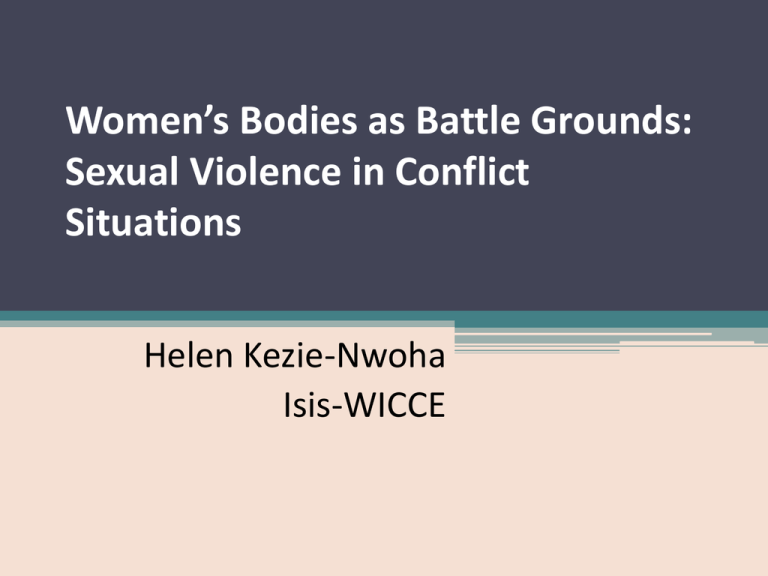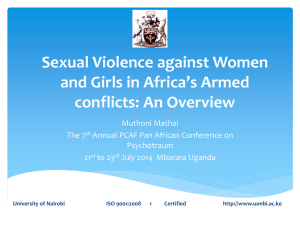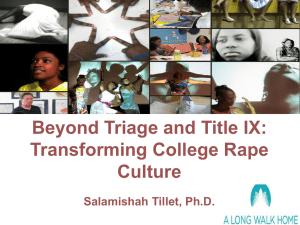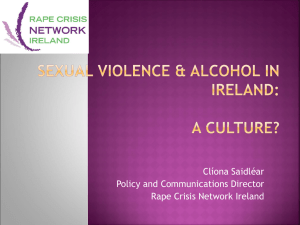
Women’s Bodies as Battle Grounds:
Sexual Violence in Conflict
Situations
Helen Kezie-Nwoha
Isis-WICCE
About Isis-WICCE
• Isis-Women’s International Cross Cultural Exchange
(Isis–WICCE) is a women’s human rights organization
whose mandate is to strengthen women’s leadership
in conflict and post conflict settings to fully
participate in peace building, good governance and
development.
• Founded in 1974 in Geneva Switzerland, the
organization relocated to Africa, in Uganda in 1994;
to tap the voices of African women and link them to
the debates and campaigns taking place at national,
regional and international levels.
About Isis-WICCE
Since 1996, Isis-WICCE
has been engaged in
researching and documenting the experiences of
women in situations of armed conflict in Africa and
globally in order to;
• expose the violations committed against women
women’s roles in conflict situations
• Use the data to strengthen women’s views with
policy and advocacy
• Provide facts (data) for post conflict planning
Sexual Violence in Conflict
• Victims of modern armed conflict are far more likely
to be civilians than soldiers, mostly women and
children
• Women face different forms of violence, which are
systematically deployed to achieve military or
political objectives.
• Rape is used to terrorize the population, break up
families, destroy communities and sometimes
deliberately used to infect women with HIV or render
them incapable of bearing children
• It has been used to change ethnic make-up of the
next generation.
Forms of Sexual Violence during
Conflict
•
•
•
•
•
Rape
Gang rape
Sexual exploitation
Sexual slavery
Forced impregnation
Global Statistics of Sexual Violence in
Conflict
According to UN reports,
• Up to 60,000 women were raped during the war in
Bosnia (1992-95)
• 14,200 rape cases registered in South Kivu, DRC between
2005-2007 just 2% of perpetrators were ever called to
account. An average of 40 women are raped daily in
South Kivu, DRC
• In Sierra Leone, between 50,000 and 64,000 internally
displaced women suffered sexual assault at the hands of
combatants (1991-2002)
• Rwandan genocide memorial notes that 500,000 women
were raped during 100 days of conflict. 10,000 genociderelated trials heard by Rwandan courts, only 3% included
convictions for sexual violence.
Current conflicts
• A report published by the Euro-Mediterranean
Human Rights Network estimates 6,000 cases of
Syrian women being sexually assaulted since the
start of the war in March 2011. (Syrian National
Reconciliation Commission is reporting 37,000
cases of rape in the suburbs of Damascus).
Isis-WICCE Research in Conflict
Settings
• A situation analysis of the women survivors of the 19892003 armed conflict in Liberia.
• Women’s experiences during Armed Conflict in Southern
Sudan, 1983 – 2005; The Case of Juba County – Central
Equatorial State.
• Documentation of Teso Women’s Experiences of Armed
Conflict; 1987-2001.
• Women’s Experiences of Armed Conflict in Uganda Gulu
District, 1986-1999.
• Women’s experiences of armed conflict in Uganda:
Luweero district 1980-1986.
Findings
• Luweero, out of 92 respondents 88 of respondents
reported having been sexually abused or knowing
someone who was sexually abused and 56% were raped
or know someone who has been raped
• In Gulu, out of 559 women interviewed 55% reported
having experienced rape or attempted rape or forced
marriage.
• In Liberia, out of 515 women interviewed, 62.5%
experienced some form of sexual torture. About 20% of
women had objects forcefully inserted in their vagina
Findings
Rampant sexual violence The studies revealed an
average of 65% of women experienced some
form of sexual violence.
“The worst thing about the Soldiers was having forced
sex with women one after another…. the NRA
soldiers started sexually abusing the women in the
compound. One woman was forced to have sex with
six NRA men, and this went on for two days”.
Respondent , Luweero Research
Women’s voices
• “I am from Kuda and my husband is a chief. When the
conflict broke out, my husband was in Torit. We ran in the
nearby bush. We came and collected vegetables and we went
back in the bush. It happened one day when my daughter in
law delivered and she could not sleep in the bush with the
baby. I found the soldiers were in the house trying to rape
her, then I told them that this lady had just delivered two
days ago, why then do you want to rape her?
•
• They said that they can leave her and they wanted me. I said
that I am an old woman and instead they replied that they
enjoyed old women better. So they raped me; they were six in
number. They just raped me outside in the open. Some of
them were beating me and others holding my hands and
legs. Juba, S.Sudan
Women’s voices
“The Rebels never left a breast-feeding woman
to go without having been raped. They believed
that breast-feeding mother’s were free from the
HIV virus. They have the belief that a woman
with children is not infected with gonorrhea”.
Voice from Teso research
Women’s voices
Violence against women’s bodies
“The rebels would start debating whether a pregnant
woman was carrying a boy or a girl to show that
they had power over life and death and to prove
how powerful they were. They would then split the
woman’s stomach to see what she was carrying.
And right there they gave themselves the power to
destroy two lives or more in case of twins just to
prove a point”. (Male Key Informant, Monrovia)
Women’s voices
“Four MPFL soldiers raped me...they threatened me
that if I refuse, they will kill me with my children. I
accepted because I wanted to save my children and I
knew they were serious...other women were raped,
mutilated and then killed for me to survive together
with my children”. Woman respondent from Liberia
Women’s voices
• “What bothers me is my poor health. From the time I
was raped, I get frequent swellings and wounds in
my vagina, heavy and painful menstruation periods
lasting for about fourteen days. As a result, I spend
sleepless nights thinking about my situation. At
times, I don’t like to meet people, especially those
who know me…I went to Atutur Hospital last year.
They told me to go back so that my uterus is
removed, but I have no money. I’m waiting to die.” A
woman respondent from Soroti
Findings
• Women survivors of sexual violence reported
reproductive health problems such as; abnormal
vaginal bleeding, abnormal vaginal discharge,
infertility, leaking urine and chronic abdominal pain
• 68% of women respondents had at least one
gynaecological complaint
Isis-WICCE Response
• Through her theory of change
‘If we provide healing for women’s bodies, mind and
spirit; and provide them with concrete skills and tools
for peace; provide opportunities for them to utilize their
potential; they will consistently advocate for responsive
intervention and policies; then the movement of women
peace activists will take charge, and consequently
contribute to a peaceful world’.
Response
• Short term emergency medical interventions.
The medical interventions have enabled over 2,000
women to receive gynecological treatment and
surgery, 2000 received counseling and trauma
management, and 3,500 received general treatment.
Challenges
• Marginalization and exclusion of women’s peace
efforts in mainstream peace negotiation processes.
• Inability to address multiple effects of armed
conflicts on women
• Persistent Militarism that target women’s bodies
Response by the UN Security Council
• Security Council Resolution 1325 (2000): increase
the participation of women in the ‘prevention and
resolution of conflicts’ and ‘maintenance and
promotion of peace and security. Protect the rights
of civilian women and girls and incorporate policies
and procedures that protect women from gender
based crimes such as rape and sexual assault.
• Security Council Resolution 1820 (2008): called for
an end to the use of acts of sexual violence against
women and girls as a tactic of war and end to
impunity of perpetrators. Re-emphasized women’s
participation in peace building.
Response by the UN Security Council
• Security Council Resolution 1889 (2009): reaffirmed
resolution 132, condemned continuing sexual violence against
women in conflict situations, and urged the UN member
States and civil society to consider the need for protection and
empowerment of women and girls, including those associated
with armed groups, in post-conflict programming.
• Security Council Resolution 1960 (2010): asked the Secretary
General to list those parties credibly suspected of committing
or being responsible for patterns of sexual violence in
situations of conflict on the Council’s agenda. It also called for
the establishment of monitoring, analysis and reporting
arrangements specific to conflict related sexual violence.
• Security Council Resolution 2122 (2013): women’s
participation, protection, access to justice and psychosocial
support
Regional responses
• The International Conference of the Great Lakes
Region SGBV Declaration (2011)
Request member States to fast track response to
sexual gender based violence survivors, through
providing health, legal and psychosocial support
to women survivors.
Recommendations..
• The need to address the root causes of conflicts rather than
symptoms of conflicts.
• Governments to implement laws and policies put in place to
address sexual violence and provide adequate budgets.
• Governments need to put in place special programmes to
address reproductive health complications in conflict settings.
• Women play a crucial role in attitude change. It is important
to build their skills in early warning,peacebuilding and post
conflict reconstruction. The use of law, protocols and
government policies alone will not succeed.
THANK YOU
FOR
LISTENING









